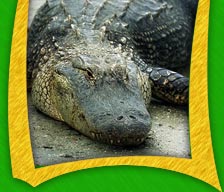|
Alligators Vs. Crocodiles
While the alligator is closely related to the crocodile,
the two animals have very distinct differences.
- Head Shape and Features - The most obvious way to tell the difference
between an alligator and a crocodile is the shape of the head.
Crocodiles has a narrower snout than alligators. In addition, crocodiles
have teeth in the lower jaw that are visible when the mouth is
shut. Only the upper teeth show when an alligator closes his snout.
Another, more difficult, way to tell an alligator and crocodile
apart is to look for the tongue. Alligators have tongues. Crocodiles
do not.
- Color - Though many people associate alligators with the color
green, adult alligators are actually black in color. Crocodiles,
on the other hand, have a brownish color.
- Habitat – While both alligators and
crocodiles can live in freshwater environments, only crocodiles
can make their homes in salt water. Crocodiles, unlike alligators,
have salt secreting glands that allow them to survive in this
environment.
- Numbers – In the United States, there
are many more alligators than crocodiles. The Florida Fish and
Wildlife Conservation Commission estimates there could be as
many as one million alligators in Florida alone. However, only
a few hundred crocodiles remain in the United States, and they
are all found in South Florida. For this reason, the government
lists the crocodile as an endangered species, while the alligator
is listed only as a species of special concern.
|
 Photo by: Susan Grundner
Photo by: Susan Grundner |
Gator Holes
Alligators play an important role in the ecosystem.
As top predators, they help control the number of rodents and other
animals that might overrun a habitat. Gators also perform a unique
service by building “gator holes.” These holes are
created in wetland environments when an alligator uses its mouth
and claws to uproot vegetation in an area. Once the space is cleared,
the gator digs a hole by shoving its body into the mud and slashing
its tail around. While the hole is usually underwater and barely
visible during wet season, it becomes an invaluable resource during
dry season. The gator hole stays full of water when everything
else dries out. It becomes the only means of survival for the gator
and other small animals, including fish, insects, crustaceans,
snakes, turtles, and birds.
Mothering Instincts
When the female alligator is ready to lay her eggs,
she builds a nest of vegetation, sticks, leaves and mud in a sheltered
spot in or near the water. After she lays her 20 to 50 white eggs,
she covers them with more vegetation. This vegetation gradually decomposes,
producing heat in the process. This heat keeps the eggs warm. The
female alligator will remain near the nest throughout the 65 day
incubation period, defending the nest from predators. When the young
hatch, they emit a high-pitched croaking sound which triggers the
mother to start digging them out of the nest. The mother then carries
the baby alligators to the water, where they separate into small
groups or pods. These pods usually stay near the mother for about
a year, if the mother remains in the area.
Resources for this article
have been provided by Wikipedia and
the US Fish and
Wildlife Service.
|














